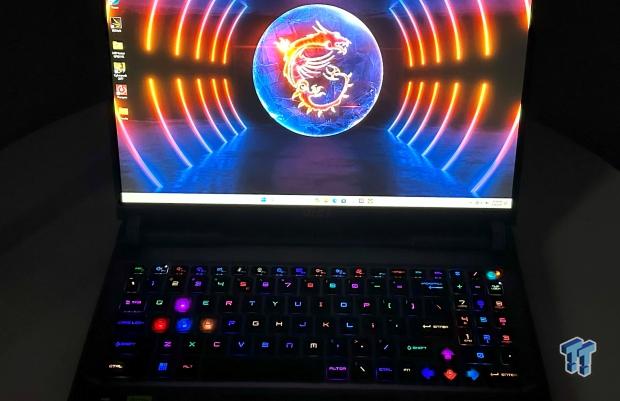
The Bottom Line
Pros
- + HDMI 2.1
- + Thunderbolt 4
- + SD 7.0 card reader
- + Gen4 NVMe
- + 144Hz display
Cons
- - Gigabit LAN
- - 720p webcam
- - 1080p display
Should you buy it?
AvoidConsiderShortlistBuyIntroduction, Specifications, and Pricing
Before we get heavy into the 14th Gen Intel Meteor Lake and Raptor Lake systems, we must first put the wraps on the 13th Gen. To do this, MSI sent over their Vector GP68, a mid-range gaming laptop that tags both 13th Gen Intel CPUs and 40 series RTX graphics to offer a rather potent combination.

Full specifications can be seen in the image above. Our sample is slightly different from what is currently available from MSI's web store, with our sample having 13950HX rather than the 13700H that is currently available. That said, the 13950HX is the base of the machine, offering eight performance cores and sixteen efficient cores; this brings the thread count to thirty-two for this machine.
Peak clock speeds land at 4GHz for the e-cores and 5.5GHz for the p-cores on a 55W TDP. Memory for this machine is DDR5 SO-DIMM, speeds at 4800MHz and capacity at 16GB from the factory, and can be upgraded to 96GB with 48GB sticks, though the CPU does support up to 192GB. The display for our Vector GP68 is a 16" IPS Panel with a maximum refresh rate of 144Hz and a resolution of 1920x1080. This is powered by the RTX 4080 Laptop GPU, which has 12GB of dedicated GDDR6.
Connectivity for this machine includes both Gigabit LAN and Wi-Fi 6e for networking, while USB connectivity includes two 3.2 Type-A ports alongside two USB-C backed by 3.2 Gen 2, both supporting DisplayPort and one with USB-PD capabilities. Further connectivity consists of a full-size SD 7.0 card reader and a 3.5mm headphone jack.
As for pricing, we found our SKU of the GP68 HX at Newegg for a touch over $2200, though the SKU outlined in the spec sheet above is currently going for $2099.

Notebook Overview
Overview

Packaging for the MSI Vector was full retail, and this includes an MSI Gaming branded box, as seen above.

The included power adapter is a proprietary model from MSI with a square connector. It is rated at 330W.

The Vector is a very clean laptop with a subtle gray colorway and the MSI Gaming badge on the back of the display.

The rear shelf of the laptop enables MSI to throw some of the connectivity at the back of the Vector. These options include the gigabit LAN port, HDMI 2.1, and USB-C, we also noted the rectangle power input here.

On the right side of the Vector, we have both Type-A USB 3.2 ports along with the USB-C port that offers PD charging.

The left side of the Vector offers the 3.5mm jack that is gold plated along with the card reader and Thunderbolt 4.

The bottom of the unit offers rubber feet to secure the laptop to your desk along with helping with airflow to the laptop. Thirteen screws can be removed here to release the cover for any cleaning or upgrades.

Opening up the Vector, we have a massive cooling array at the top with copper heat pipes. Below that, we have room for dual SO-DIMM slots offset to the right and dual NVMe slots to the left. To the far left, we have the M.2 Wi-Fi card. At the very bottom, we have the battery, which checks in at 90Wh.

Booting up the Vector, we have a full-size keyboard from Steelseries, plenty of mechanical feedback, and a good-sized trackpad that is centered in the chassis.

Lights dimmed, the Vector offers full RGB with WASD a little brighter than the rest with transparent key caps.
BIOS/UEFI and Software





Click BIOS is what we have on the Vector; this includes a main tab that includes hardware information. The advanced tab will give you access to the VMD controller to set up RAID on NVMe. Additionally, you can control hyperthreading and Cstates in this menu. The boot menu is quite simple with just boot order and options like fast boot while security allows users to configure BIOS passwords and secure boot.
Software

The software included is MSI Center, which includes the dashboard seen above for monitoring the hardware.

Further options include user scenarios and GPU switches.

Last, MSI Center does allow you to add modules to the interface.
System/CPU Benchmarks
Cinebench
Cinebench is a long-standing render benchmark that has been heavily relied upon by both Intel and AMD to highlight their newest platforms during unveils. The benchmark has two tests: a single-core workload utilizing one thread or 1T. There is also a multi-threaded test that uses all threads or nT of a tested CPU.

With no comparisons built up with Cinebench 2024, we have raw results in the screenshot above. Single core gets 122 points from the 13950HX while nT picks up 1672 points.
AIDA64 Memory

Memory bandwidth gives us 82K in read, 64K in write, and 68K in copy. Latency landed at 84ns.
BAPCo CrossMark
CrossMark™ is an easy-to-run native cross-platform benchmark that measures the overall system performance and system responsiveness using models of real-world applications. CrossMark™ supports devices running Windows, iOS, and macOS platforms.

We have cleaned up our charts as we move towards 14th-generation systems, keeping the best AMD and Intel platforms we have tested. The Vector lines up quite well in CrossMark, scoring 2048 overall and taking the second spot in our chart.
Geekbench 6

With Geekbench, the Vector once again lands towards the top of our chart, picking up 2762 single core and 17378 multi-core.

GPU testing in Geekbench was quite good, too; apart from going against a host of RTX 4090, the Vector with its RTX 4080 matched the Razer Blade with 204K in OpenCL and 181K in Vulkan.
UL Benchmarks and Gaming
UL Benchmarks

PCMark kicked off our UL testing. The Vector pulled 12621 overall, matching the similar spec Blade 16.

CPU Profile for one and two threads put the Vector at the top of our charts, with an 1162 1T score and a 2290 2T score.

Getting into higher thread counts, the Vector holds its own with a sixteen thread score of 9796, a touch better than the Blade 16.

Storage included with the GP68 scored a 428 MB/s bandwidth in 3Dmark.

Speed Way was our only real synthetic "gaming" benchmark. In this workload, the Vector pulled a score of 4862, about 200 points higher than the Blade 16.

Cyberpunk testing landed at 61.2 FPS on average with the Ultra preset.
Final Thoughts
The Vector GP68, and perhaps all Vectors, are a unique lineup, mid-range by design with the 144Hz 1080p screen but high-end if we look at the hardware and features of the laptop itself. Our sample of the GP68 does this with an RTX 4080 and 13950HX CPU at the heart, while this laptop also offers other hallmarks of higher-end laptops like SO-DIMM slots, Gen4 NVMe, and even upgradable m.2 WIFi. On top of that, connectivity is quite good on this offering, despite obvious corners cut with the 720p webcam and 1Gbe LAN, I tend to give MSI a pass because they have included Thunderbolt 4 and HDMI 2.1 on this laptop along with additional USB 3.2 ports.
The trackpad and keyboard are both solid, the keyboard has plenty of mechanical feedback, though not too clicky, and the RGB lighting is customizable. The trackpad has a solid enough click to be usable for productivity, though it's probably at the smaller end when it comes to size, that said I do enjoy it being centered in the chassis.
Testing the performance of the Vector GP68, this machine performed very well overall and was second to the Blade 16 in CrossMark and PCMark workloads. CPU-heavy workloads like Geekbench, Cinebench, and CPU Profile showed the Vector GP68 at the top of our charts, only beaten in CPU Profile by the 7745HX from AMD. Storage performance was solid, middle of our charts with 428 MB/s bandwidth, this is certainly an area where consumers can upgrade if they want to. Looking at gaming performance, we have 3Dmark Speed Way running about 200 points higher on the Vector than it did with the Blade 16, and our run-through with Cyberpunk with its Ultra preset and Ray tracing netted us 61 FPS.
The Vector GP68's pricing, as detailed in the review, is currently around $2200 on Newegg. The MSI web store offers a similar configuration for $200 less than we detailed in the intro; this is about $1000 cheaper than the closest configuration on the Blade 16. That said, Razer doesn't offer a 1080p panel for its 16" laptop; instead, it gives you a QHD display alongside 32GB of memory.




